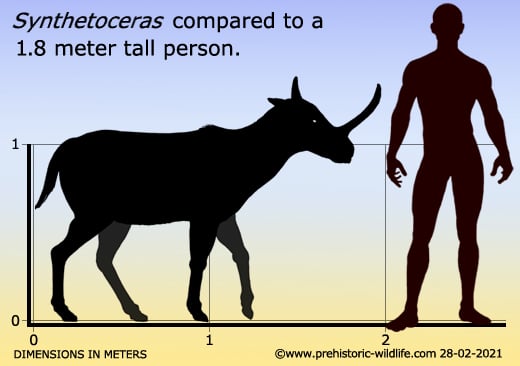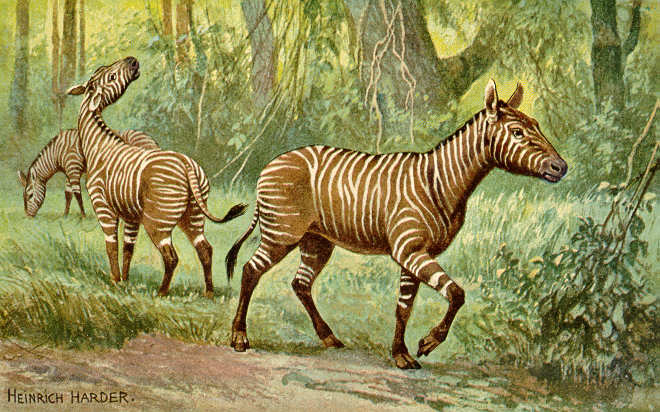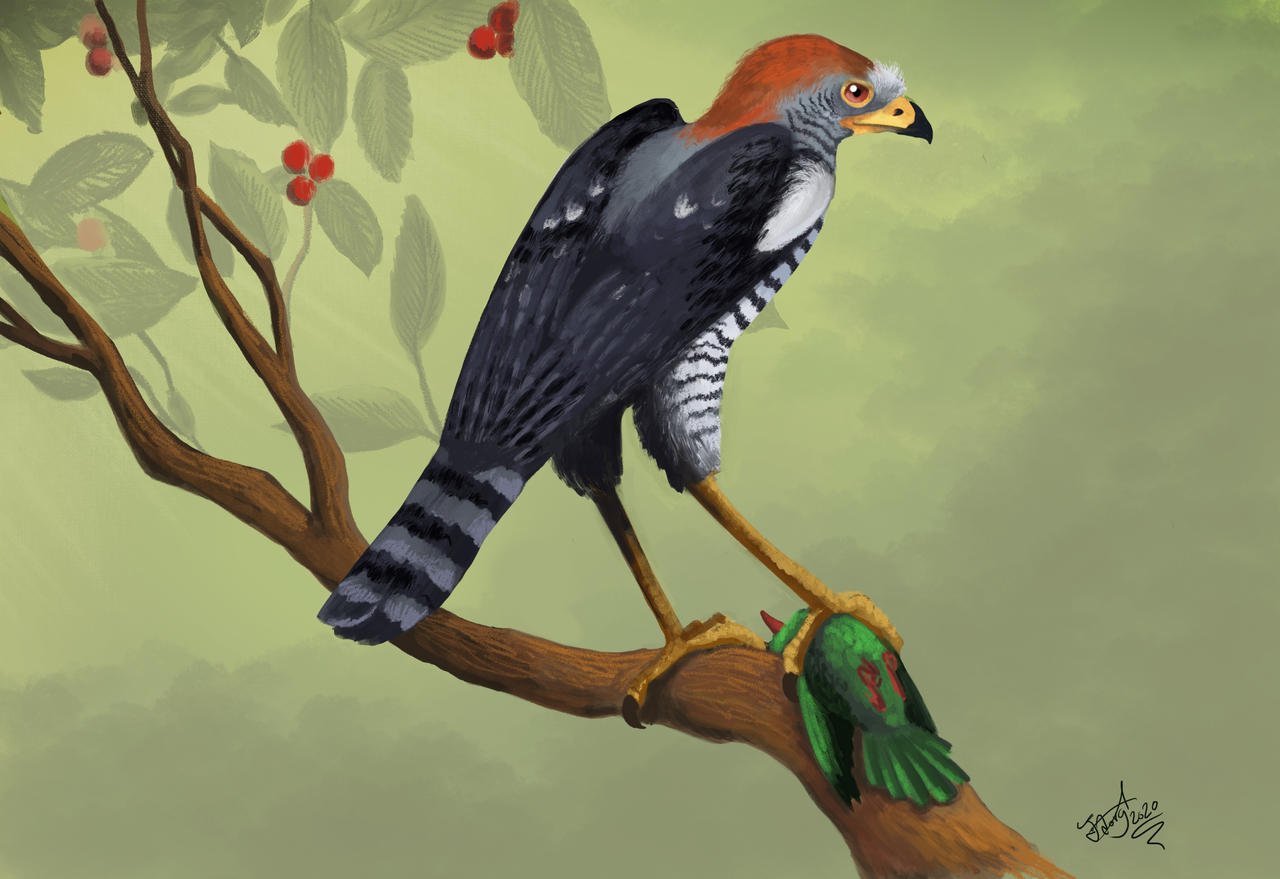|
|
Post by Talira Greycrest on Sept 18, 2021 13:45:54 GMT
Name: TylocephalonyxPronunciation: Ty-loe-sef-a-lon-ixMeaning of name: "Knob head claw"Species: T. skinneriSize: 2.2 metres long, 1.8 metres tall and weighing around 600kgsFamily: ChalicotheriidaeDiet: HerbivoreFirst fossils found: Known from several specimens discovered in the western and midwestern United States. Named by M. C. Coombs in 1979.Lived: 20.43 to 15.97 million years ago during the Burdigalian stage of the Early Miocene in what is now the western and midwestern United States.

|
|
|
|
Post by Talira Greycrest on Sept 19, 2021 10:38:16 GMT
Name: SynthetocerasPronunciation: Sin-thet-o-seh-rasMeaning of name: "Combined horn"Species: S. tricornatus, S. davisorumSize: Depending on species, measured up to 2 metres long, 1.5 metres tall and weighing between 80 and 300kgsFamily: ProtoceratidaeDiet: HerbivoreFirst fossils found: Known from several partial skeletons discovered in the south-central and midwestern United States. S. tricornatus named by R. A. Stirton in 1932. S. davisorum named in 2006.Lived: Depending on species, lived between 10.3 and 5.3 million years ago from the Tortonian stage of the Late Miocene through to the Zanclean stage of the Early Pliocene in what is now the midwestern and south-central United States.
|
|
Tix Mascot
Tech guru
Italy is my second homeland
Posts: 11,093  Mini-Profile Background: {"image":"http://4.bp.blogspot.com/-X5mhw13BJ7Y/TwKeZ3uM7YI/AAAAAAAABPw/D82go4Ny_8E/s1600/italy-background-8-787281.jpg","color":""}
Mini-Profile Text Color: 0ef8f1
Mini-Profile Name Color: f40d39
Year of Birth: 1961
Nationality: Norwegian
Mini-Profile Background: {"image":"http://4.bp.blogspot.com/-X5mhw13BJ7Y/TwKeZ3uM7YI/AAAAAAAABPw/D82go4Ny_8E/s1600/italy-background-8-787281.jpg","color":""}
Mini-Profile Text Color: 0ef8f1
Mini-Profile Name Color: f40d39
Year of Birth: 1961
Nationality: Norwegian
|
Post by Tix Mascot on Sept 19, 2021 18:05:42 GMT
Strange with that big horn...
|
|
|
|
Post by Talira Greycrest on Sept 20, 2021 7:40:30 GMT
Name: HypohippusPronunciation: Hy-poe-hip-pusMeaning of name: "Low horse"Species: H. affinis, H. osborni, though it's possible there could be more.Size: 1.8 metres longFamily: EquidaeDiet: HerbivoreFirst fossils found: Known from several specimens discovered in the western and midwestern United States. H. affinis named by American palaeontologist, Joseph Mellick Leidy, in 1869. H. osborni named by J. W. Gidley in 1907.Lived: Depending on species, lived between 17 and 11 million years ago from the Burdigalian stage of the Early Miocene through to the Tortonian stage of the Late Miocene in what is now the western and midwestern United States. Artist's impression of Hypohippus Artist's impression of Hypohippus
|
|
Tix Mascot
Tech guru
Italy is my second homeland
Posts: 11,093  Mini-Profile Background: {"image":"http://4.bp.blogspot.com/-X5mhw13BJ7Y/TwKeZ3uM7YI/AAAAAAAABPw/D82go4Ny_8E/s1600/italy-background-8-787281.jpg","color":""}
Mini-Profile Text Color: 0ef8f1
Mini-Profile Name Color: f40d39
Year of Birth: 1961
Nationality: Norwegian
Mini-Profile Background: {"image":"http://4.bp.blogspot.com/-X5mhw13BJ7Y/TwKeZ3uM7YI/AAAAAAAABPw/D82go4Ny_8E/s1600/italy-background-8-787281.jpg","color":""}
Mini-Profile Text Color: 0ef8f1
Mini-Profile Name Color: f40d39
Year of Birth: 1961
Nationality: Norwegian
|
Post by Tix Mascot on Sept 20, 2021 16:55:47 GMT
Probably the ancestors of modern zebras.
|
|
|
|
Post by Joey12 on Sept 20, 2021 21:44:29 GMT
They are almost the same. And I think shorter than most horses. So Lo Horse sounds about right.
|
|
|
|
Post by Talira Greycrest on Sept 21, 2021 10:35:00 GMT
Name: SaghacetusPronunciation: Sag-ha-see-tusMeaning of name: "Sagha whale", after the Qasr el Sagha Formation of central Egypt where its fossils were discovered.Species: S. osirisSize: Uncertain due to a lack of fossils.Family: Dorudontinae (a subfamily of Basilosauridae)Diet: CarnivoreFirst fossils found: Known only from a partial skull and jaws discovered in the Qasr el Sagha Formation of central Egypt in 1879. Named by American palaeontologist, Philip Dean Gingerich, in 1992.Lived: 37.2 to 33.9 million years ago during the Priabonian stage of the Late Eocene in the shallow seas that once covered what is now central Egypt. S. osiris skull on display at the Muséum national d'Histoire naturelle, Paris S. osiris skull on display at the Muséum national d'Histoire naturelle, Paris
|
|
|
|
Post by Joey12 on Sept 22, 2021 8:22:38 GMT
Looks like a Carnivore.
|
|
|
|
Post by Talira Greycrest on Sept 22, 2021 10:21:10 GMT
Despite its dino-like name, this animal is a primitive whale: Name: BasilosaurusPronunciation: Ba-sil-oh-sore-usMeaning of name: "King lizard"Species: B. cetoides, B. isisSize: Depending on species, measured between 15 and 20 metres long and weighing up to 60 metric tonnes.Family: BasilosauridaeDiet: CarnivoreFirst fossils found: Known from several specimens discovered in Jordan, Tunisia, Pakistan, Egypt, Western Sahara, Morocco and the United States. B. cetoides named by American palaeontologist, Richard Harlan, in 1834. B. isis named by British palaeontologist, Charles William Andrews, in 1904. Was originally thought to be a mosasaur.Lived: 41.3 to 33.9 million years ago from the Lutetian stage of the Early Eocene through to the Priabonian stage of the Late Eocene in the oceans that once covered what is now Jordan, Tunisia, Pakistan, Egypt, Western Sahara, Morocco and the United States. |
|
Tix Mascot
Tech guru
Italy is my second homeland
Posts: 11,093  Mini-Profile Background: {"image":"http://4.bp.blogspot.com/-X5mhw13BJ7Y/TwKeZ3uM7YI/AAAAAAAABPw/D82go4Ny_8E/s1600/italy-background-8-787281.jpg","color":""}
Mini-Profile Text Color: 0ef8f1
Mini-Profile Name Color: f40d39
Year of Birth: 1961
Nationality: Norwegian
Mini-Profile Background: {"image":"http://4.bp.blogspot.com/-X5mhw13BJ7Y/TwKeZ3uM7YI/AAAAAAAABPw/D82go4Ny_8E/s1600/italy-background-8-787281.jpg","color":""}
Mini-Profile Text Color: 0ef8f1
Mini-Profile Name Color: f40d39
Year of Birth: 1961
Nationality: Norwegian
|
Post by Tix Mascot on Sept 22, 2021 18:28:18 GMT
Similar to some types of modern whales.
|
|
|
|
Post by Joey12 on Sept 23, 2021 5:41:15 GMT
First one I've seen with a whales tail.
|
|
|
|
Post by Talira Greycrest on Sept 23, 2021 10:25:05 GMT
Name: AviraptorPronunciation: A-ve-rap-torMeaning of name: "Bird thief"Species: A. longicrusSize: Uncertain, but is estimated to have been around the same size as the modern Little sparrowhawk.Family: AccipitridaeDiet: CarnivoreFirst fossils found: Known only from a single, almost-complete skeleton discovered in Poland. Named by German palaeontologist, Gerald Mayr, and Norwegian palaeontologist, Jørn Harald Hurum, in 2020.Lived: 31 to 30 million years ago during the Rupelian stage of the Early Oligocene in what is now Poland. Artist's impression of Aviraptor Artist's impression of Aviraptor
|
|
Tix Mascot
Tech guru
Italy is my second homeland
Posts: 11,093  Mini-Profile Background: {"image":"http://4.bp.blogspot.com/-X5mhw13BJ7Y/TwKeZ3uM7YI/AAAAAAAABPw/D82go4Ny_8E/s1600/italy-background-8-787281.jpg","color":""}
Mini-Profile Text Color: 0ef8f1
Mini-Profile Name Color: f40d39
Year of Birth: 1961
Nationality: Norwegian
Mini-Profile Background: {"image":"http://4.bp.blogspot.com/-X5mhw13BJ7Y/TwKeZ3uM7YI/AAAAAAAABPw/D82go4Ny_8E/s1600/italy-background-8-787281.jpg","color":""}
Mini-Profile Text Color: 0ef8f1
Mini-Profile Name Color: f40d39
Year of Birth: 1961
Nationality: Norwegian
|
Post by Tix Mascot on Sept 23, 2021 14:40:40 GMT
That type of bird hasn't changed much during 30 million years.
|
|
|
|
Post by Joey12 on Sept 24, 2021 7:13:11 GMT
Looks like a falcon or some type hawk.
|
|
|
|
Post by Talira Greycrest on Sept 26, 2021 8:52:22 GMT
Name: PseudocyonPronunciation: Soo-do-sy-onMeaning of name: "False dog"Species: P. sansaniensis, P. steinheimensis, P. styiacusSize: Depending on species, measured around 2.5 metres long, 1.2 metres tall and weighing 773kgsFamily: AmphicyonidaeDiet: CarnivoreFirst fossils found: Known from several specimens discovered throughout Eurasia and the United States. P. sansaniensis named in 1851. P. steinheimensis named in 1885. Uncertain of when P. styiacus was named.Lived: Depending on species, lived between 15.97 and 12.75 million years ago during the Langhian and Serravallian stages of the Middle Miocene in what is now Eurasia and the United States.

|
|